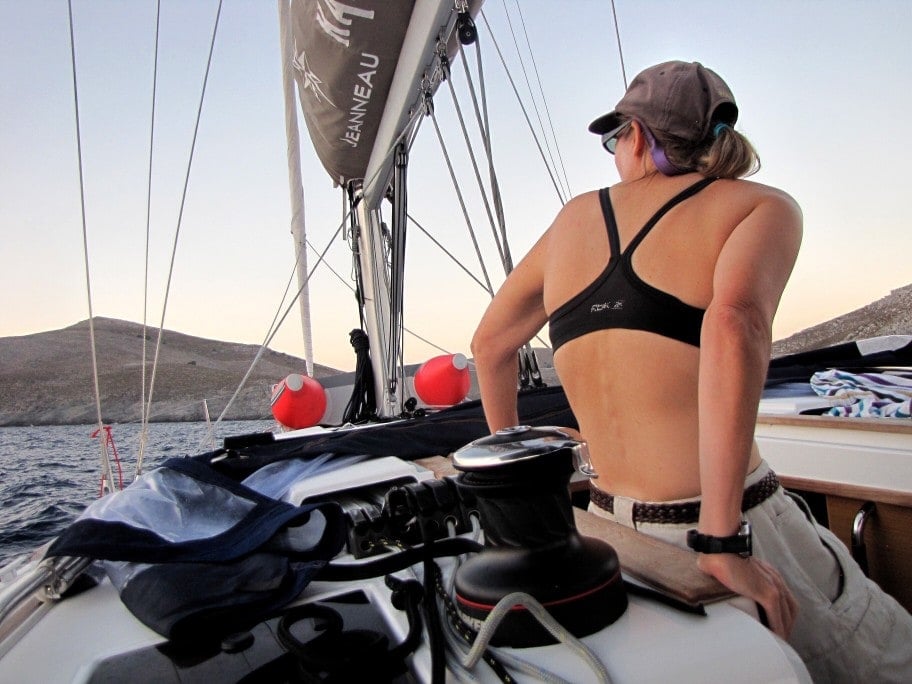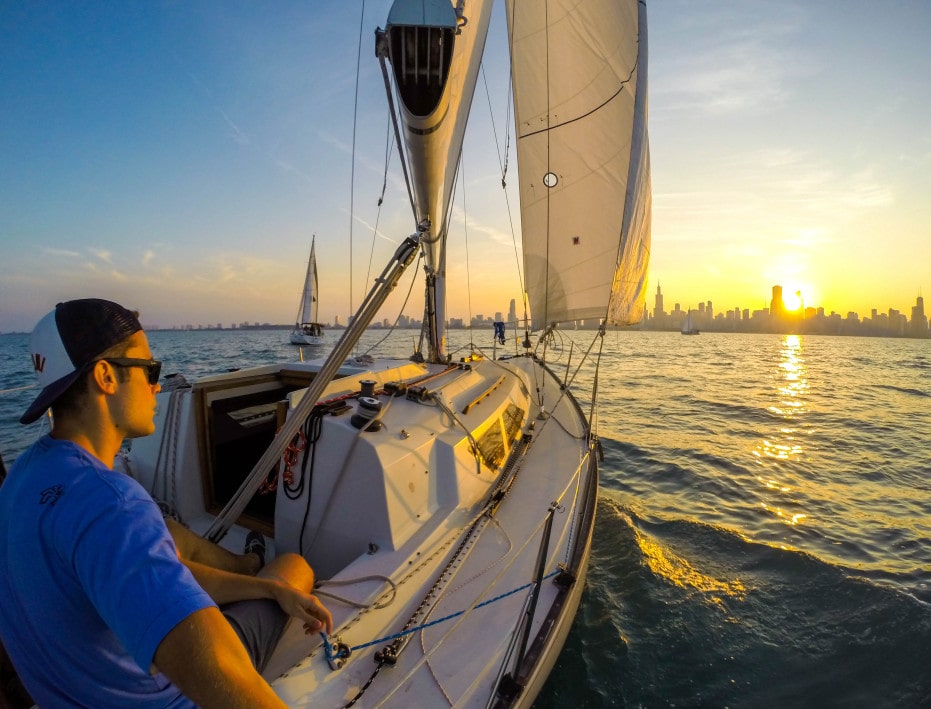Can You Sail With Just The Mainsail?
Whether you are just getting started with sailing or you’ve been sailing for years, you may wonder how effective the mainsail can be on its own. The mainsail is a versatile sail that can be used in a variety of situations, including by itself.
Can You Sail With Just The Mainsail?
Can you sail with just the mainsail? Any sailboat can be sailed with the mainsail alone. Using only the mainsail will reduce your speed, but it can make your boat easier to handle, especially by yourself. Furthermore, using a mainsail alone is safer in some circumstances and can increase your visibility.
This is everything that you need to know about sailing your boat with the mainsail alone, including what circumstances are best suited to this kind of sailing, and what the advantages and disadvantages are.
Can You Sail With Just The Mainsail?
Any sailboat can be sailed with just the mainsail. The smallest of casual sailboats may only have a mainsail.
Sailing with just the mainsail can be a good choice when you are on a casual outing and don’t want to worry about making good time, when you are single-handling your sailboat, and when visibility is essential.
What Is The Mainsail?
The mainsail is the sail located farthest back towards the stern of the boat. It is attached to the boom, which is the horizontal rod attached to the mast.
When the boat turns, the mainsail swings on the boom to tack or jive. It is generally the sail that is raised first and the most essential sail on the boat.
Why Would You Sail With Only The Mainsail?
Most sailboats have at least two sails for good reason. Both the main and the jib are generally used to provide the best possible speed and handling for your boat.
That said, there may be times when you choose only to sail under the mainsail. Here are a few reasons you might consider this.
Easy Handling
On many boats, it is easier to raise the mainsail and handle the boat under this one sail than it is to raise and handle both sails.
On days when you have the family out for a casual sail or you’re doing some slow trolling fishing, you may decide that the easier handling of sailing under the mainsail alone is desirable.
On such days, you may not care as much about making good time, so the easy handling of using the mainsail by itself is worth the lost time.
Single Handling
If you’re taking your sailboat out by yourself, there is a good chance that you’ll only decide to use one sail. This is especially true if you aren’t accustomed to single-handling your sailboat yet.
It can be much harder to raise both sails and handle them by yourself. Many sailboats are set up in such a way that it is easy to raise the mainsail primarily from the cockpit, but you may need to go further onto the deck to raise the jib.

It may be a lot easier for you to steer while raising the mainsail from the cockpit and not worry about raising the jib. This is also important if you’re worried about dropping the sails in a hurry, for instance, if a storm comes up.
When you are working alone, you’ll be able to lower the sail much faster if you only have the main up.
Visibility
On the majority of sailboats, the jib sail is more likely to infringe upon vision than the mainsail.
If you have an exceptionally large jib, so large that it overlaps the mast, called a genoa, you may notice significantly reduced visibility when you have the jib sail up.
The jib can block your entire view to leeward, while the main sits over your head and usually doesn’t block hardly any visibility at all.
Whether you just want to take in the sights or you’re worried about hitting something, during times when you want the highest possible visibility, you may choose to only use the main.
Level Sailing
If you are on a monohull sailboat, raising the sails will tend to cause the boat to keel over. For many sailors, this is one of the most exciting aspects of sailing.
A tilted boat is proof that the sails are full of wind. It gives you a feeling of speed and adventure as you surf through the waves at an angle.
However, many people find that they are more likely to get seasick when sailing this way.
Waves tend to be more choppy as well. Using only the mainsail levels the boat out, so it is less likely to slant even in strong winds, which is a more comfortable sail for some people.
Impending Storm
The wind at the front of a storm can provide a surge of power to keep you ahead of the storm. This wind is known as a gust front, a plough wind, or a downburst, along with other names. These winds are often very consistent, as well as being delightfully cool.
Many sailors take advantage of this reliable wind at the front of a storm to speed them towards their destination, keep them ahead of the storm, and also create lovely sailing conditions.
Needless to say, if the storm overtakes a sailboat in full sail, the results could be disastrous.
Sailing with just the mainsail lets you take advantage of the gust front in front of the storm but also makes it much easier for you to drop the sail at the last second when the storm is about to overtake you.
You can also drop the sail down the mast by degrees as the wind picks up.
Comparison Chart
| Mainsail Alone | Jib and Mainsail |
| Slower speeds, generally only about five knots for 15 knots of wind on average and unlikely to achieve greater speed with higher winds | Faster speeds, takes advantage of higher wind speeds to increase sailboat speed |
| Steadier ride, even monohulls tend to stay upright and stable | Most sailboats lean to one side under the increased wind of both sails |
| Greater visibility since the jib tends to be the sail that blocks vision to the leeward side the mast | Reduced visibility, with the jib blocking the entire leeward side and a spinnaker blocking even more visibility if used |
| Easier handling. Many main sails can be raised from the cockpit while the sailor can still steerSlightly more challenging handling since both sails must be adjusted when the boat tacks or jibes and since jibbs usually need to be raised from the deck, not the cockpitSafer in high winds, since the mainsail can be dropped partially to adjust for increasing winds and because the mainsail can be very rapidly dropped if wind suddenly increasesMore dangerous in high winds, since the jib is harder to handle under intense winds due to not being attached to the boom and because you would need to drop both the main and the jib if conditions suddenly worsened. |
How Fast Does A Sailboat Go With Just The Mainsail?
How fast your boat will go if you only have the mainsail up depends on a number of variables, including what kind of sailboat you have, how big your mainsail is, and what the conditions are.
In general, the mainsail is often thought of as the steering sail and the jib as the sail that provides the power.

The mainsail is less flexible and gathers less wind, so you will not make nearly as good of time using just the mainsail, regardless of the wind conditions.
In general, if you have a breeze of around 15 knots, you can expect to maintain about five knots per hour under the mainsail at an ideal reach. If you are often tacking, trying to keep a sharp downwind or upwind reach, or there isn’t much wind, you’ll make even less headway.
Is It Better To Sail With Just The Mainsail Or Only The Jib Sail?
If you only want to use one sail the next time you go sailing, which sail should it be? Sailboats can function with either the jib or the main used alone. For strict downwind sailing, you may also be able to use only a Spinnaker.
Which sail works best alone depends on the conditions and sailing goals. If speed is less important than visibility and steering, the mainsail is probably your best choice.
If your main goal is to make good time under reduced sails, the jib or Spinnaker is probably a better option.
Do All Sailboats Have Mainsails?
All sailboats, no matter the size, function, or how many hulls they have, have mainsails. The mainsail is an essential sail on the boat and is attached to the boom. Very small hobby boats may only have a mainsail.
The only time that you may see a boat with another sail that doesn’t have a mainsail are conversion kits that do not rely on a mast and boom.
Any sailboat equipped with a mast and boom will also have a mainsail.
